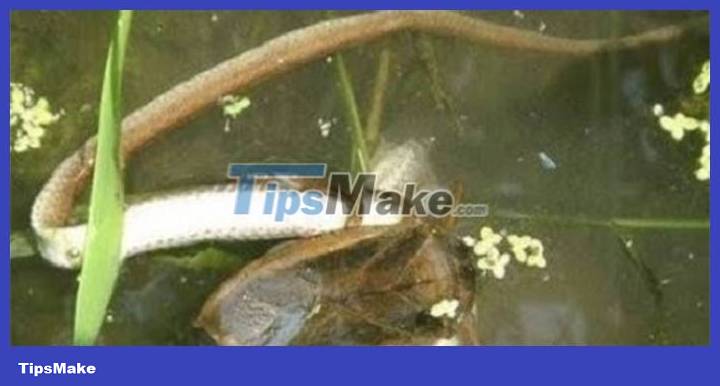Video: Giant water beetle stalks to catch turtles, fish, snakes in the water
Giant water beetles of the family Lethocerinae, although only a maximum body length of 15cm, are voracious predators and are professional hunters. They specialize in perching on an underwater plant and lie dormant for prey. When prey appears, they grab it and eat it. Giant water bugs can hunt everything from ducklings to venomous snakes.
This brown bug hangs upside down from the trees where they are perched, and breathes through a "tube" protruding from the back. When prey approaches, water beetles use their long legs to quickly grab them and then use their dagger-like proboscis to inject digestive enzymes, possibly anesthetic chemicals, and tear their prey apart.

The male giant water beetle is responsible for looking after the eggs and protecting them from predators such as ants. The female beetle, so eager to find a mate, is willing to eat another female's eggs to steal a mate, so that the male will take care of her eggs.
Water beetle pupae have a life cycle of 60 days and have bent front legs, which make them easier to catch prey. They usually hatch in the season when small prey is not abundant, so they are forced to hunt much larger prey such as tadpoles or fish.
Giant water bugs are nocturnal animals that can fly. They migrate based on the light of the full moon. The weapon that helps this creature defeat its prey is a venomous bite. There are some cases where people have been bitten by water bugs and the pain can last for hours.
You should read it
- T-rex dinosaur confronts Titanoboa, the largest giant python in Earth's history
- Instructions for using water swab machine
- 15 most giant animals in the natural world
- Giant water columns discovered on Saturn's moon Enceladus
- Top 4 best selling hot and cold water plants today
- Top 5 best water toothpick machines today
 The wild buffalo was knocked to the ground by the rhinoceros and was thrown into the air
The wild buffalo was knocked to the ground by the rhinoceros and was thrown into the air Cheetah encounters lion, who is the winner?
Cheetah encounters lion, who is the winner? Are fish thirsty?
Are fish thirsty? Male turtles fight to compete for mates, causing female turtles to almost die of suffocation
Male turtles fight to compete for mates, causing female turtles to almost die of suffocation The most venomous snake in Vietnam, the king cobra is still far behind
The most venomous snake in Vietnam, the king cobra is still far behind What does the world look like through an animal's point of view?
What does the world look like through an animal's point of view?